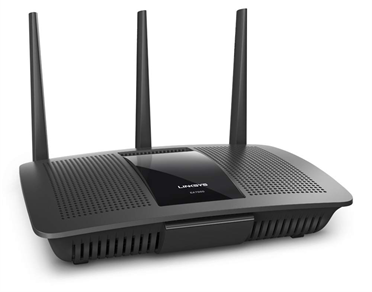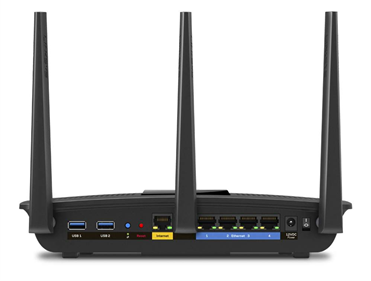Linksys Releases The Max-Stream EA7500 AC1900 MU-MIMO Router
The market for MU-MIMO devices exploded at the start of this year during CES, and now we're finally seeing these devices come to market. The release of MU-MIMO products has been almost limited to AC2600 routers, but vendors seem to be scheduling product releases in a trickling-down fashion. Linksys has followed this trend with the release of the EA7500 Max-Stream AC1900 MU-MIMO Gigabit Wi-Fi Router.
The Linksys EA7500 has a pretty standard feature set as AC1900 routers go. It's equipped with a dual core Qualcomm IPQ processor at 1.4GHz and supports speeds on up to 1300Mbps on 5GHz and up to 600Mbps on 2.4GHz. On the IO, there are five Gigabit ports, four for LAN and one for WAN, one USB 3.0 port, one USB 2.0 port and one power jack.
Traditional Wi-Fi routers can only service one device at a time in a round-robin fashion. Typically, the speeds provided are more than adequate for the router's connected devices. However, the wireless applications we use nowadays consume more data, and when several devices are streaming heavy content, the round-robin approach loses its potency.
With the EA7500, Linksys hopes to bypass the aforementioned limits with 802.11ac Wave 2 technology and specifically, MU-MIMO. What MU-MIMO does is send data to more than one device simultaneously. MU-MIMO technology effectively multitasks, allowing data-intensive applications such as 4K streaming and multiplayer gaming to be performed on multiple devices without interruption.
The Linksys EA7500 Max-Stream AC1900 MU-MIMO Gigabit Wi-Fi Router is currently available at select online and brick-and-mortar retailers at an MSRP of $199.99
Alexander Quejado is an Associate Contributing Writer for Tom's Hardware and Tom's IT Pro. Follow him on Twitter and Facebook.
Follow us on Facebook, Google+, RSS, Twitter and YouTube.
Get Tom's Hardware's best news and in-depth reviews, straight to your inbox.
Tom's Hardware is the leading destination for hardcore computer enthusiasts. We cover everything from processors to 3D printers, single-board computers, SSDs and high-end gaming rigs, empowering readers to make the most of the tech they love, keep up on the latest developments and buy the right gear. Our staff has more than 100 years of combined experience covering news, solving tech problems and reviewing components and systems.
-
ubercake I'd say let other people try these things out before you buy them. As an owner of the EA6500 AC1750 router, I know what it's like for the 2.4 and 5GHz bands to sporadically drop out on you whenever. Look at the EA6500 reviews on the egg and various other sites. When they run, they're fantastic, but they are completely unreliable. The 5GHz band was less trouble than the 2.4GHz, but I could be sitting at a PC a wall+20 feet away from the router and the signal strength would vary from 1-4 bars with the speed going from 1.3Gbps down to 214Mbps-ish with no one else in the house and no other wireless gadgetry running.Reply
I had the same issue with the Netgear C6300 (another AC1750 device). The 2.4 and 5GHz bands would dropout (even with the indicator lights for the bands simply shutting off).
I'm not sure if it's the "beamforming" that's not quite perfected and causing the dropouts or what, but to me it seems they are having some kind of issue with these higher-end AC routers that include the "beamforming" (not part of the AC standard, mind you) technology.
I plugged my trusty old Netgear WNDR3700 N router in and it runs like a champ in the exact same environment.
I guess what I'm trying to say is if you buy these things, save your receipt and be ready for a trip back to the store or an RMA if the bands begin dropping out on you within a week. -
dark_lord69 ReplyI'd say let other people try these things out before you buy them. As an owner of the EA6500 AC1750 router, I know what it's like for the 2.4 and 5GHz bands to sporadically drop out on you whenever. Look at the EA6500 reviews on the egg and various other sites. When they run, they're fantastic, but they are completely unreliable. The 5GHz band was less trouble than the 2.4GHz, but I could be sitting at a PC a wall+20 feet away from the router and the signal strength would vary from 1-4 bars with the speed going from 1.3Gbps down to 214Mbps-ish with no one else in the house and no other wireless gadgetry running.
I had the same issue with the Netgear C6300 (another AC1750 device). The 2.4 and 5GHz bands would dropout (even with the indicator lights for the bands simply shutting off).
I'm not sure if it's the "beamforming" that's not quite perfected and causing the dropouts or what, but to me it seems they are having some kind of issue with these higher-end AC routers that include the "beamforming" (not part of the AC standard, mind you) technology.
I plugged my trusty old Netgear WNDR3700 N router in and it runs like a champ in the exact same environment.
I guess what I'm trying to say is if you buy these things, save your receipt and be ready for a trip back to the store or an RMA if the bands begin dropping out on you within a week.
I wouldn't touch a Linksys since they've been bought by Belkin. I would expect exactly that type of quality...
ASUS makes some excellent routers now though. -
Don't things like normal geomagnetic fluctuations and solar flares continuously affect these radio waves? Never expect hardline predictability with a wireless anything. That a module is continuously above 214 Mbps is great, and more than anyone truly requires from wifi.Reply
-
ubercake Reply17532323 said:Don't things like normal geomagnetic fluctuations and solar flares continuously affect these radio waves? Never expect hardline predictability with a wireless anything. That a module is continuously above 214 Mbps is great, and more than anyone truly requires from wifi.
When the 5GHz hadn't completely dropped out, 214 was ok, but in games such as BF4, I knew my speed was down because the packet loss icon was coinciding with the loss of bandwidth.
And like I said, I plugged my trusty old Netgear WNDR3700v2 N router and no problems from cosmic interference. It runs like a champ. It is also dual band, but does not offer the same maximum speeds. It offers 100% reliability and I'd rather have that than an occasional 1.3Gbps data rate.



